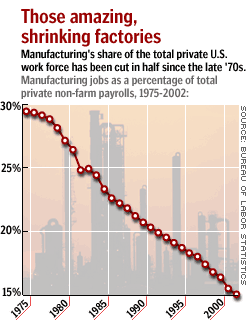NEW YORK (CNN/Money) - The nation's economists have long taken consumer confidence surveys with a grain of salt, since consumers don't always spend the way they feel.
Recent data from the nation's factory sector suggest that the analysts may need to reach for the salt shaker when reading manufacturing confidence surveys as well.
Data released Tuesday helped to illustrate the point: the New York Fed's index of business conditions in the state's factory sector jumped to the highest level on record in February while the full Federal Reserve reported its manufacturing index rose a respectable, but hardly blockbuster, 0.3 percent in January.
The national Fed's report is based on actual data and was lower than the January readings from the New York Fed, based on a survey of about 100 businesses in New York State, and the Institute for Supply Management, based on a survey of about 400 industrial companies nationwide, had indicated.
The New York Fed's report in January was the second-highest reading in the survey's brief 2-1/2-year history, while the January ISM index was the highest in 20 years.
| Related stories
|

|
|
|
|
"There's a disconnect between these surveys and the industrial output figures themselves," said Kevin Logan, chief economist at Dresdner Kleinwort Wasserstein. "It may be that things were down for so long in manufacturing that any improvement looks strong in the eyes of the manufacturers, but the level of output remains rather low."
This disconnect has been especially noticeable in the employment indexes of the various surveys.
The New York Fed's employment index has shown gains in hiring since October, the Philadelphia Fed's index of factory employment in Pennsylvania, New Jersey and Delaware has also been positive since October, and the ISM's employment index has been positive since November.
But manufacturing payrolls have been shrinking for 42 straight months, according to the Labor Department, as the factory sector continues to be the hardest-hit by the 2001 recession, and the unusually slow labor market recovery that's followed.
"The ISM data really do look very strong, but you have to remember that these surveys simply ask whether things are getting better, getting worse, or staying the same," said David Sloan, senior economist at 4CAST Ltd., a market and economics research firm in New York.
"They measure the breadth of improvement, but not the magnitude of it -- if a lot of people see things getting just a little better, that can produce a very strong ISM number."
Shrinking factory sector
The manufacturing sector's share of the total economy has been shrinking steadily for decades, and it currently accounts for about 15 percent of gross domestic product (GDP), the broadest measure of the economy.

That could be another reason for the apparent divergence between survey results and output -- if a shrinking number of businesses are all happy, then survey results will look good, but output will be less robust.
Still, economists keep a close eye on manufacturing because it's so sensitive to shifts in the economy. When demand for products rises or falls, factories have to start or stop production, perhaps revealing the economy's broader strength or weakness more quickly than the service sector might.
There's no doubt that manufacturing activity has improved from a long slump that began before the latest recession and ended well after it, and some economists expect it will keep improving this year.
"We expect that manufacturing will maintain a 6 percent rate of growth in 2004 and actually grow faster than the overall economy for the first time in four years," said Jerry Jasinowski, president of the National Association of Manufacturers.
 |
YOUR E-MAIL ALERTS
|
Follow the news that matters to you. Create your own alert to be notified on topics you're interested in.
Or, visit Popular Alerts for suggestions.
|
|
|
Such forecasts have led some economists to believe that a rebound in factory hiring is just around the corner -- but it's unlikely that most or all of the millions of jobs lost in recent years will ever return.
The main culprit -- if that's the right word -- is productivity, or output per worker hour, which has grown at an astonishing clip in recent years, driven by improvements in technology, along with the movement of lower-skilled jobs overseas.
Productivity and outsourcing keep prices low and free up money for new product development, eventually creating new jobs, most analysts say, but that also could mean a slow labor-market recovery in the short run.
"Manufacturing output is up, yet employment in the manufacturing sector is down," Wachovia chief economist John Silvia said in a research note. "This result suggests that the firms are producing more in the U.S., but doing it with fewer workers."

|

